BY124 Gibbons Ch 26- Phylogeny and the Tree of Life
1/61
There's no tags or description
Looks like no tags are added yet.
Name | Mastery | Learn | Test | Matching | Spaced |
|---|
No study sessions yet.
62 Terms
The science that identifies, names, and classifies new species
Taxonomy
Swede who developed taxonomy
Carl Linneaus
Genus and Species
Binomial nomenclature
Taxonomic Hierarchy
D, K, P, C, O, F, G, S
study of diversity of life and evolutionary relationships
Typically employs the use of phylogenies/ phylogenetic trees/ cladograms
It’s a subclass of taxonomy
Systematics
Equivalent to convergent evolution. Common traits found in different groups of species which are anatomically different, serve the same function, but evolved independently. No relation to each other
Analogy is similarity due to convergent evolution
Analogous trait
Evolutionary relationship of organism or genes- anything related by descent
Often visualized by a phylogenetic tree
Phylogeny
NO
Is evolution linear?
In actuality, phylogenetic trees have ______________.
branches
Many trees exhibit extinct species that are not direct ancestors of today’s existing species.
any species or group of species shown on the tree
Taxon/Taxa
A _____________ tree includes a branch to represent the most recent common ancestor of all taxa in the tree
Rooted
When a branch splits, that means that one species splits into two,
which can then result in separate _____________.
Lineages
The ________ ____________ _____________ ancestor for different lineages occurs at most recent branch point that connects the lineages
most recent common
In an evolutionary tree, a splitting is equivalent to ___________
speciation
Basal Taxon
A ______ ________ diverges early in the history of a group and originates near the common ancestor of the group
Evolutionary Tree of Life
No need to memorize
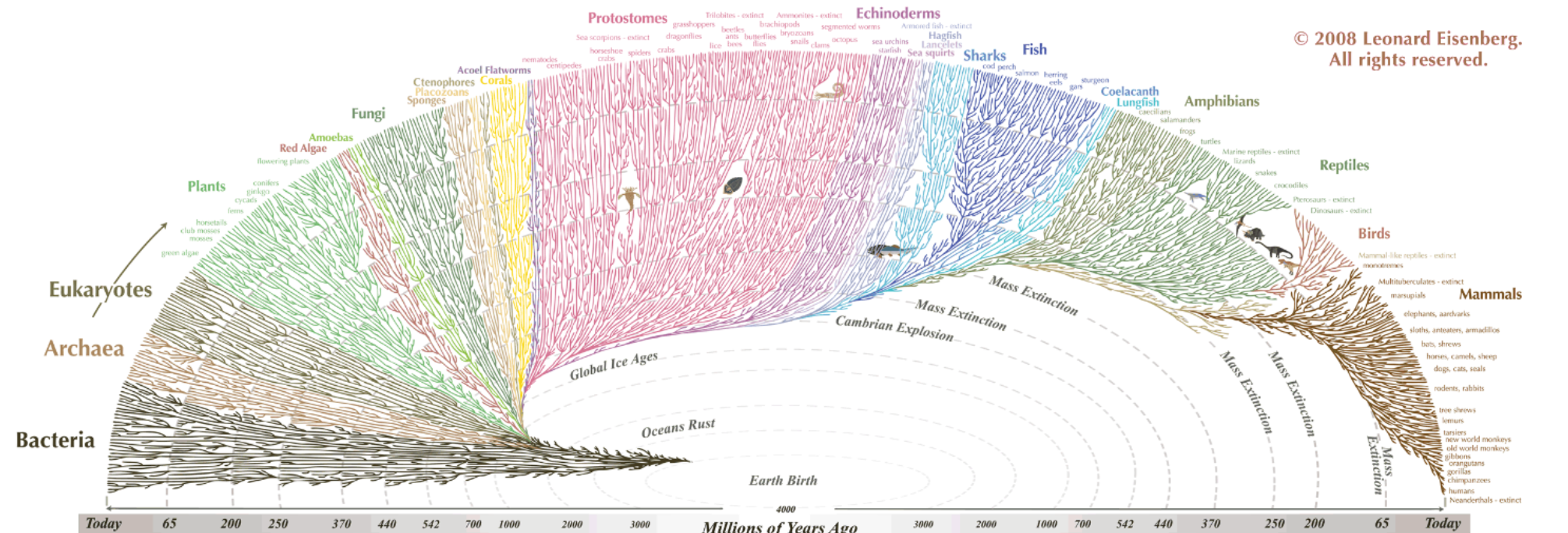
Homology
(physical traits and molecular sequence) is similarity due to shared ancestry
(ex. Similar bones in front limbs of vertebrates)
______________ look for evolutionary relationships between species.
Compare morphology and genetic information to look for similarities.
The more similar, more likely homology.
Systematists
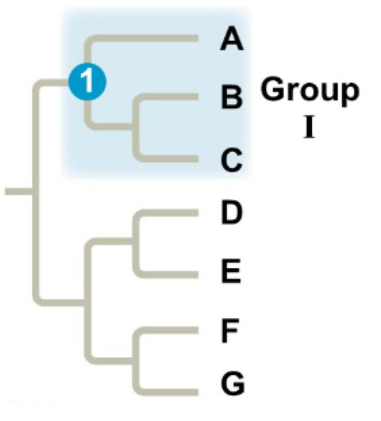
a group of species that includes an ancestral species and all
descendants.
Clade/Monophyletic Group

grouping with ancestral species and some but not all descendants
Paraphyletic Group

includes distantly related species, but not their most recent common ancestor.
Often represents analogous features/convergent evolution
Polyphyletic Group
Members of this kind of grouping will share the MOST traits:
A. Paraphyletic
B. Polyphyletic
C. Monophyletic
Monophyletic
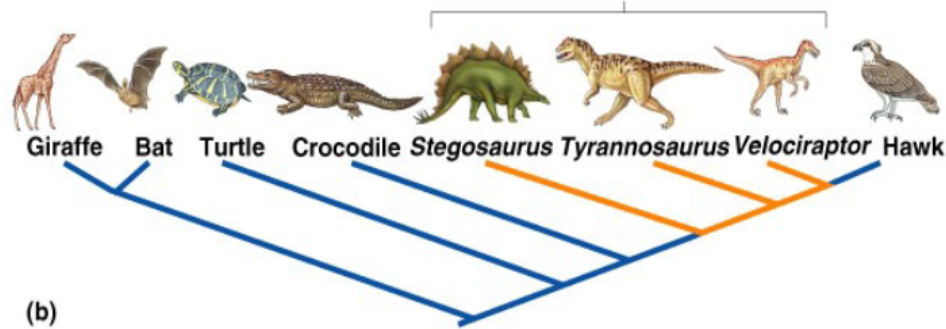
In the image below, animals with wings make up...
A. a clade
B. a paraphyletic group
C. a polyphyletic group
D. an ancestral group
C. a polyphyletic group
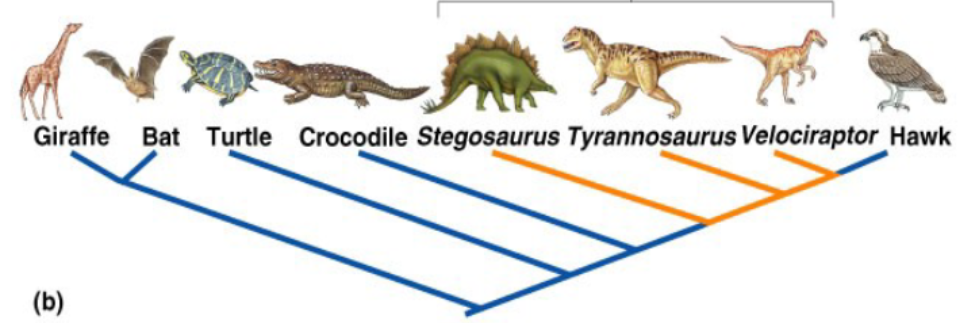
In the image below, dinosaurs are...
A. a clade
B. a paraphyletic group
C. a polyphyletic group
D. an ancestral group
B. a paraphyletic group
In comparison with its ancestor, an organism has both shared and different __________.
Characters
A ______ _________ _________ is a character that originated in an ancestor of the taxon
(ex, hinged jaw ancestral to mammals, amphibians, reptiles, fish)
shared ancestral character
A ______ _______ _________ is an evolutionary novelty unique to a particular clade (ex, only mammals have hair)
shared derived character
A character can be both ancestral and derived, depending on the ___________
context
Evolutionary relationships shown in DNA and proteins
Closer match between sequences = more recent common ancestor
DNA/ amino acid sequences can be in the same way as shared ancestral and shared derived characters in order to build a tree
Common genetic code for all living things evidence of relatedness
How trees are built: molecular biology
Did humans evolve from chimpanzees?
Lots of extinct lineages in the ancestral history of humans
No, but we have a common ancestor that lived about 6 million years ago
Prior understanding: 5 kingdoms (Monera, Protista, Plantae, Fungi, Animalia) and NO domains
Genetic data showed that Kingdom Monera (all the bacteria) was made up of 2 very different groups (making it obsolete)
Kingdom Protista had organisms that were more similar to plants/animals than they were to each other, so it was eliminated.
Phylogenies changed our understanding of the Tree of Life
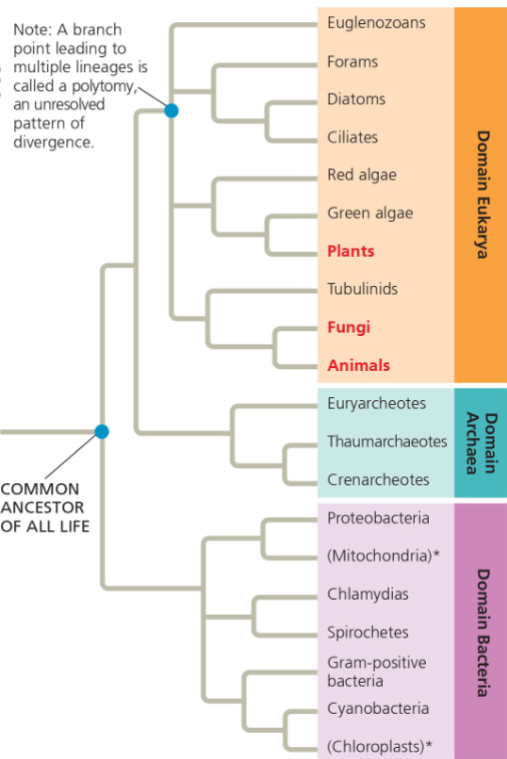
According to this phylogeny, which two domains are most closely related?
A. Eukarya and Archaea
B. Eukarya and Bacteria
C. Archaea and Bacteria
A. Eukarya and Archaea
Horizontal Gene transfer: genes are transferred from one genome (species) to another
How???
transposable elements and plasmids, viral infection, fusion of hosts and their endosymbionts
About 80% of the genes in 181 prokaryotic genomes have been moved between species
Explains why phylogenies can be difficult to construct
Horizontal gene transfer complicates evolutionary relationships!
The role of horizontal gene transfer
A taxon __________.
is a species
is a formal grouping at any given level
is a clade
is a formal grouping in any level from phylum to species
of one type of organism at one level is comparable to another type of organism at the same level
is a formal grouping at any given level
By applying a molecular clock, researchers have proposed that the first HIV-1 M invasion into humans occurred in the __________.
1830s
1890s
1930s
1950s
1980s
1930s
A bald eagle and a black bear both have four limbs with digits because they are both tetrapods, descendants of a four-limbed ancestor. In this comparison, the limbs of the eagle and the bear are what type of structure?
Vestigial
Paralogous
Homologous
Exaptations
Analogous
Homologous
Key word- ancestor
The idea of using molecules as clocks to time evolutionary events is very attractive, but there are many problems in actually applying the technique. What seems to be the best way to get reliable results?
It is important to use as many genes as possible. With this approach, fluctuations in evolutionary rate will tend to average out.
It is important to use one gene in which the changes are clearly neutral.
It is important to use a gene that has been affected by natural selection to ensure that evolution will be observed.
It is important to use one gene in which the changes are clearly neutral.
It is best to use a gene that is essential to survival because they change more slowly.
It is important to use as many genes as possible. With this approach, fluctuations in evolutionary rate will tend to average out.
Which of the following is an assumption that should be made when reading a phylogenetic tree?
A taxon on a phylogenetic tree evolved from the taxon next to it.
The sequence of branching in a tree indicates the absolute ages of the particular species.
None of the listed assumptions should be made.
Species in taxa arising from the same branch point should appear most similar to each other.
All of the listed assumptions should be made.
None of the listed assumptions should be made.
The term polytomy refers to a situation in which __________.
a branch point within a phylogenetic tree represents the most recent common ancestor of all the taxa in the tree
multiple common names apply to one species
there is a branch point on a phylogeny from which more than two descendent groups emerge
any lineages on a phylogeny diverge
separate lineages independently evolve similar structures
there is a branch point on a phylogeny from which more than two descendent groups emerge
The binomial system assigns to each organism a unique name that describes its __________.
family and species
body plan and habitat
evolutionary history
genus and species
order and family
genus and species
Which of the following is the correct order of taxonomic levels in the Linnean system of classification, from most to least inclusive?
Kingdom, domain, order, phylum, class, family, genus, species
Domain, kingdom, phylum, class, order, family, genus, species
Kingdom, domain, phylum, order, class, family, genus, species
Phylum, domain, kingdom, class, order, family, genus, species
Phylum, domain, kingdom, family, class, order, genus, species
Domain, kingdom, phylum, class, order, family, genus, species
A phylogenetic tree of bird families constructed by cladistic analysis would be a hypothesis about which of the following?
Families that look most alike
Analogous structures shared by various species
Evolutionary relationships among bird families
Relative ages of living species of birds
Characteristics shared by all bird families
Evolutionary relationships among bird families
If you wanted to determine the lineage of plants that have evolved on a relatively young archipelago—approximately 15,000 years old—what type of nucleic acid should you compare?
mtDNA
rRNA
tRNA
mRNA
Nuclear DNA miRNA
mtDNA
The separate lineages leading to dolphins and sharks both evolved streamlined bodies, dorsal fins, and broad tail fins as adaptations to efficient locomotion in a marine environment. In this comparison, the bodies and fins of dolphins and sharks are what type of structures?
Vestigial
Paralogous
Exaptations
Homologous
Analogous
Analogous
What is the relationship between systematics and taxonomy?
Systematics is a discipline within taxonomy.
Systematics has replaced taxonomy.
Systematics and taxonomy are alternative approaches to the same goal.
Systematics and taxonomy are the same thing.
The development of systematics preceded that of taxonomy.
Systematics is a discipline within taxonomy.
Looking at the character table and phylogenetic tree above, which of the following is a true statement?
Four walking legs is a shared derived character in mammals (leopard).
Hair is a shared ancestral character in mammals (leopard).
The amniotic egg is a shared derived character in amphibians (frog).
A backbone is a shared ancestral character in mammals (leopard).
Hinged jaws are derived from lampreys.
A backbone is a shared ancestral character in mammals (leopard).
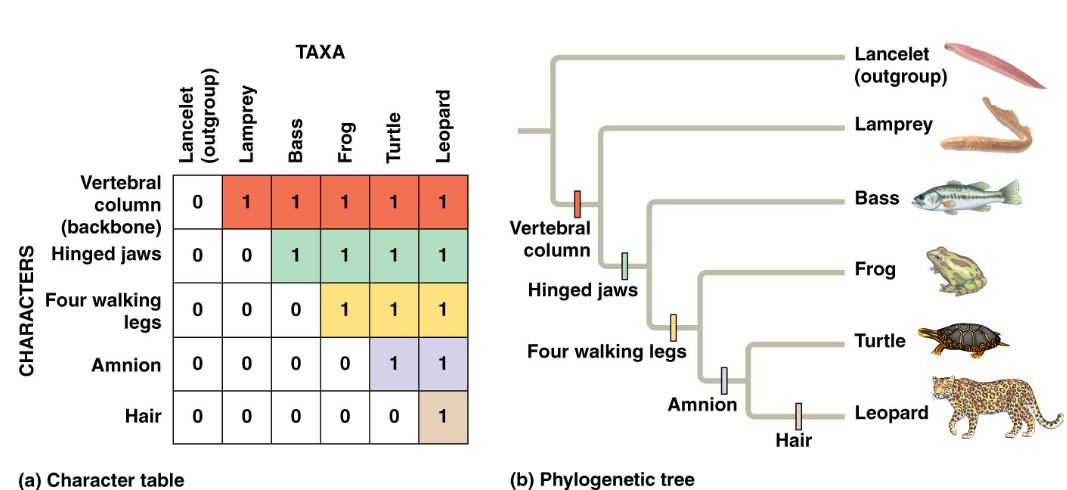
What is a primary reason why a three-domain taxonomic scheme has been adopted over the previous five-kingdom taxonomic scheme?
Phylogenies based on genetic data revealed that some prokaryotes (kingdom Monera) differ as much from each other as they differ from eukaryotes.
The five-kingdom taxonomic scheme was never widely accepted.
The three-domain taxonomic scheme was necessary to further partition each kingdom as new species were discovered.
More detailed analysis of the phenotypes of unicellular eukaryotes indicated that they did not belong in any of the five kingdoms.
The five-kingdom system failed to distinguish between prokaryotes and eukaryotes.
Phylogenies based on genetic data revealed that some prokaryotes (kingdom Monera) differ as much from each other as they differ from eukaryotes.
In cladistics, biologists attempt to place species into groups that each include an ancestral species and all of its descendants. A group that is paraphyletic fails to accomplish this goal in what way?
It consists of an ancestral species and some, but not all, of its descendants.
The ancestral member is identified only by fossil evidence.
All members of the group are extinct.
It includes species grouped based only on phenotypic similarities.
It includes species with different ancestors.
It consists of an ancestral species and some, but not all, of its descendants.
In a cladistic approach to systematics, an outgroup is __________.
the group of the most closely related species determined from the output of the cladistic analysis
the most recent common ancestor of all the species under study
a species or group of species from an evolutionary lineage that is known to have diverged before the lineage that includes all the species under study
a species or group of species, including all of the species under study, incorrectly assigned to the lineage
the most recently evolved descendant or group of descendants to have come from the species under study
a species or group of species from an evolutionary lineage that is known to have diverged before the lineage that includes all the species under study
Researchers can use molecular homologies to __________.
reveal the number of mutations in a particular sequence that has occurred in each species since they diverged from a common ancestor
estimate how long ago the common ancestor lived
hypothesize about the behavior of a common ancestor
All of the listed responses are correct.
hypothesize about the morphological structures of a common ancestor
reveal the number of mutations in a particular sequence that has occurred in each species since they diverged from a common ancestor
Which of the following would be the least useful in determining the relationships among various species?
A comparison of DNA base sequences
Amino acid sequences of proteins
Homologous structures
Fossils
Analogous structures
Analogous structures
Which of the following is a true statement concerning horizontal gene transfer?
Horizontal gene transfer is a hypothetical means of transferring genes between organisms for which evidence has been observed only in laboratory animals.
Horizontal gene transfer has only negative consequences for a lineage.
There is evidence that horizontal gene transfer has occurred rarely in the evolutionary history of life.
Horizontal gene transfer occurs only in certain prokaryotes.
Horizontal gene transfer is known to occur within both prokaryotes and eukaryotes.
Horizontal gene transfer is known to occur within both prokaryotes and eukaryotes.
Birds and mammals have a four-chambered heart, but most reptiles have a three-chambered heart. How does this fact affect the construction of phylogenetic trees for these groups?
None of the listed responses is correct.
The most likely tree is always the most parsimonious.
This represents a problem with the principle of parsimony, rather than a problem with the analogy-homology issue.
The most likely tree is not always the most parsimonious.
It shows that the common ancestor of birds and mammals must have had a four-chambered heart.
The most likely tree is not always the most parsimonious.
What is the basis for the use of a molecular clock to determine the absolute time of evolutionary change?
DNA degrades at a known rate following the death of an organism.
The rate of mutation increases following divergence in a lineage.
Nucleotide substitutions in a gene occur at a relatively constant rate.
Rates of nucleotide substitutions have increased throughout the history of life on Earth.
Natural selection occurs at a constant rate.
Nucleotide substitutions in a gene occur at a relatively constant rate
Which of the following best summarizes the neutral theory?
Darwinian selection does not influence a lot of evolutionary change in genes and proteins because many of these changes do not affect fitness.
Differences in the rate of the clock in different genes are a function of how important each gene is.
If a particular sequence of amino acids is critical for survival, most new mutations will be harmful and fewer will be neutral. These genes will change slowly over time.
Most mutations lead to dramatic changes in the evolution of a species.
Most harmful mutations are removed from a population quickly.
Darwinian selection does not influence a lot of evolutionary change in genes and proteins because many of these changes do not affect fitness.
Sister taxa on a phylogenetic tree are defined as groups that __________.
appear most similar due to convergent evolution
compete for resources in the same habitat
share an immediate common ancestor and are each other’s closest relatives
arise from different branches at the same time
share an immediate common ancestor and are each other’s closest relatives
Two genes are recognized as orthologous if __________.
they are genes present in the same species that have opposing effects on the phenotype
they are homologous genes found in the same species due to gene duplication
they are homologous genes found in different species, and their divergence traces back to speciation events that produced the species
they are analogous genes found in the same species, representing independent mutations producing similar phenotypes
they are analogous genes found in different species, representing independent mutations producing similar phenotypes
they are homologous genes found in different species, and their divergence traces back to speciation events that produced the species
The principle of maximum parsimony is applied to the process of constructing a phylogenetic tree in what way?
The tree that requires the fewest evolutionary events, as measured by the origin of shared derived characters, is selected.
The process of constructing a phylogenetic tree is kept simple by including few species in the study.
A phylogenetic tree is constructed using only the characters that can be measured in living organisms.
The tree that requires the fewest branch points is selected.
Whenever possible, biologists continue to use previously constructed phylogenies.
The tree that requires the fewest evolutionary events, as measured by the origin of shared derived characters, is selected.
Why are phylogenetic trees considered hypotheses?
A phylogenetic tree can be used to make testable predictions.
Darwinian evolution is a hypothesis, and therefore a phylogenetic tree representing evolutionary history is necessarily also hypothetical.
The fossil record is not an adequate source of evidence in drawing conclusions about evolutionary histories.
Current genetic analyses are not yet accurate enough to permit conclusions about evolutionary histories.
There are competing ideas about the evolutionary history of any taxonomic group.
A phylogenetic tree can be used to make testable predictions.
Rabbits and guinea pigs both belong to class Mammalia. This means they must also both belong to __________.
phylum Chordata
order Rodentia
genus Cavia
family Caviidae
All of the listed responses are correct.
phylum Chordata
Three living species X, Y, and Z share a common ancestor T, as do extinct species U and V. A grouping that consists of species T, X, Y, and Z (but not U or V) makes up __________.
a paraphyletic group
a valid taxon
a monophyletic clade
an ingroup, with species U as the outgroup
a polyphyletic group
a paraphyletic group
Using cladistic analysis, a taxonomist wishes to construct a phylogenetic tree showing the relationships among various species of mammals. Which of the following would be the least useful for this purpose?
The fact that all mammals have hair
Descriptions of various types of limbs (wings, legs, flippers, etc.)
Data about skull bones
The fact that teeth vary among types of mammals
DNA base sequences
The fact that all mammals have hair